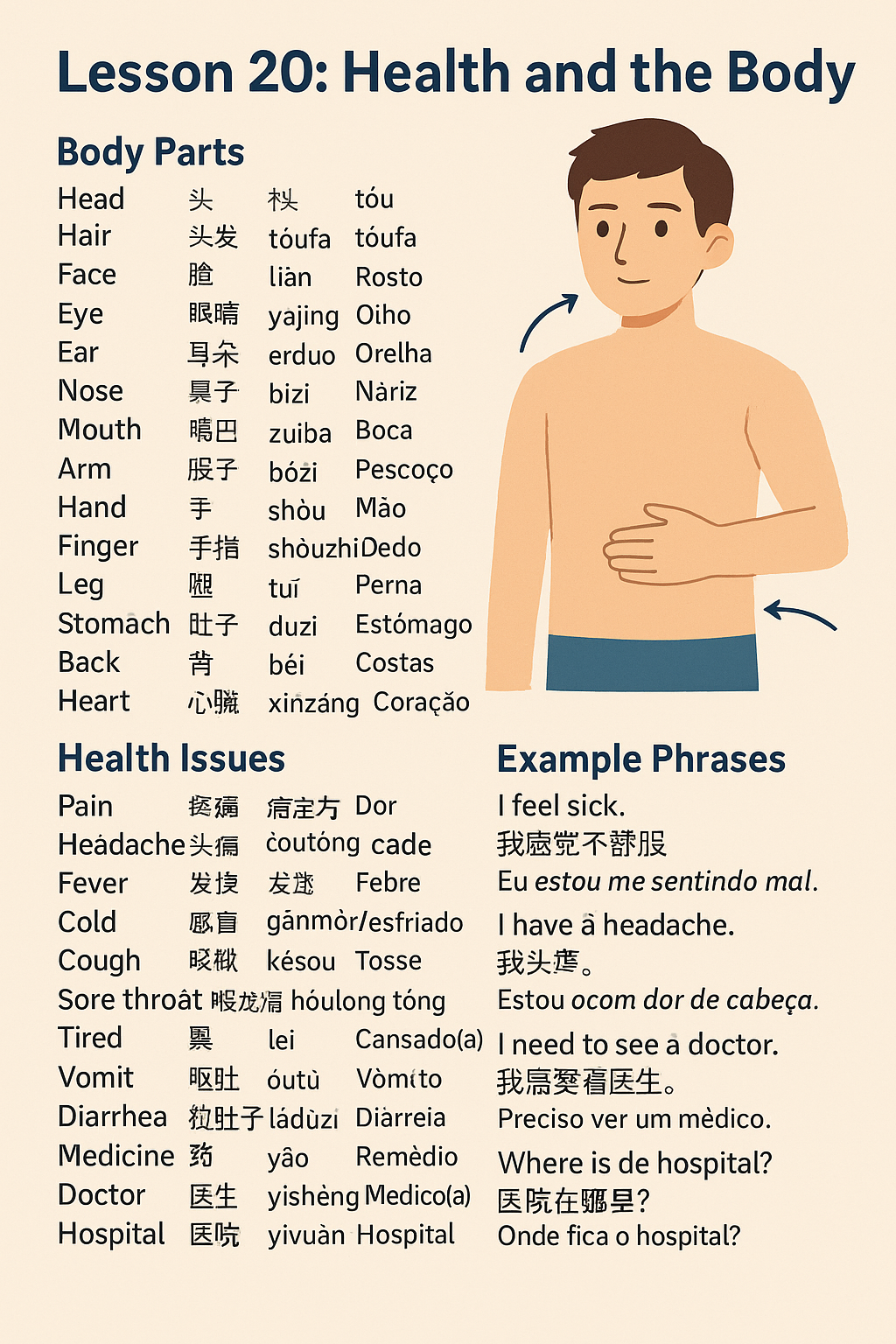🔤 Languages: English | 中文 (Mandarim, with Pinyin) | Português
📘 Level: Beginner/Intermediate
🎯 1. Objectives | Objetivos | 学习目标
By the end of this lesson, you will:
-
Know how to name body parts and common health issues.
-
Express how you feel (e.g., sick, tired, in pain).
-
Ask for and understand basic medical help in three languages.
-
Describe body parts and symptoms clearly.
🧠 2. Vocabulary | Vocabulário | 词汇
✅ Body Parts | Partes do Corpo | 身体部位
| English | Chinese (中文) | Pinyin | Português |
|---|---|---|---|
| Head | 头 | tóu | Cabeça |
| Hair | 头发 | tóufa | Cabelo |
| Face | 脸 | liǎn | Rosto |
| Eye | 眼睛 | yǎnjing | Olho |
| Ear | 耳朵 | ěrduo | Orelha |
| Nose | 鼻子 | bízi | Nariz |
| Mouth | 嘴巴 | zuǐba | Boca |
| Neck | 脖子 | bózi | Pescoço |
| Arm | 胳膊 | gēbo | Braço |
| Hand | 手 | shǒu | Mão |
| Finger | 手指 | shǒuzhǐ | Dedo |
| Leg | 腿 | tuǐ | Perna |
| Foot | 脚 | jiǎo | Pé |
| Stomach | 肚子 | dùzi | Estômago |
| Back | 背 | bèi | Costas |
| Heart | 心脏 | xīnzàng | Coração |
✅ Common Health Issues | Problemas de Saúde | 常见健康问题
| English | Chinese (中文) | Pinyin | Português |
|---|---|---|---|
| Pain | 疼痛 | téngtòng | Dor |
| Headache | 头痛 | tóutòng | Dor de cabeça |
| Fever | 发烧 | fāshāo | Febre |
| Cold | 感冒 | gǎnmào | Gripe/resfriado |
| Cough | 咳嗽 | késou | Tosse |
| Sore throat | 喉咙痛 | hóulóng tòng | Dor de garganta |
| Tired | 累 | lèi | Cansado(a) |
| Vomit | 呕吐 | ǒutù | Vômito |
| Diarrhea | 拉肚子 | lādùzi | Diarreia |
| Medicine | 药 | yào | Remédio |
| Doctor | 医生 | yīshēng | Médico(a) |
| Hospital | 医院 | yīyuàn | Hospital |
🗣️ 3. Useful Phrases | Frases úteis | 实用句子
✅ English
-
I feel sick.
-
I have a headache.
-
I need to see a doctor.
-
Where is the hospital?
-
Are you okay?
-
Take this medicine.
✅ 中文
-
我感觉不舒服。
Wǒ gǎnjué bù shūfu. -
我头疼。
Wǒ tóuténg. -
我需要看医生。
Wǒ xūyào kàn yīshēng. -
医院在哪里?
Yīyuàn zài nǎlǐ? -
你还好吗?
Nǐ hái hǎo ma? -
吃这个药。
Chī zhège yào.
✅ Português
-
Eu estou me sentindo mal.
-
Estou com dor de cabeça.
-
Preciso ver um médico.
-
Onde fica o hospital?
-
Você está bem?
-
Tome este remédio.
📖 4. Grammar Focus | Foco Gramatical | 语法重点
✅ English:
Subject + have/feel + symptom
-
I have a fever.
-
I feel tired.
✅ Chinese:
Subject + 有 / 是 + 症状
-
我发烧了。
Wǒ fāshāo le. -
我很累。
Wǒ hěn lèi.
✅ Português:
Eu + estou com / sinto + sintoma
-
Estou com febre.
-
Eu me sinto cansado(a).
💬 5. Dialogue Practice | Prática de Diálogo | 对话练习
🏥 Dialogue – At the Clinic
ENGLISH
A: Hello, what’s wrong?
B: I have a sore throat and a fever.
A: You need to rest and take this medicine.
中文
A:你好,哪里不舒服?
Nǐ hǎo, nǎlǐ bù shūfu?
B:我喉咙痛,还有发烧。
Wǒ hóulóng tòng, háiyǒu fāshāo.
A:你需要休息,吃这个药。
Nǐ xūyào xiūxí, chī zhège yào.
PORTUGUÊS
A: Olá, o que está sentindo?
B: Estou com dor de garganta e febre.
A: Você precisa descansar e tomar este remédio.
🧑⚕️ 6. Cultural Insight | Dica Cultural | 文化小贴士
-
In China, traditional medicine (中药 zhōngyào) is often used along with modern treatment.
-
In Mozambique and Brazil, public health centers are available but sometimes limited—private clinics are preferred when possible.
-
In English-speaking countries, walk-in clinics and pharmacies are widespread and easy to access for minor issues.
✍️ 7. Writing Task | Tarefa de Escrita | 写作任务
Describe a time you were sick. Include:
-
Symptoms you had
-
What you did (e.g., went to doctor, took medicine)
-
What helped you recover
Português (Exemplo):
Semana passada, eu estava com gripe. Tive febre e dor de cabeça. Fui ao médico, tomei remédio e descansei muito. Agora estou melhor.
Mandarim (Exemplo):
上个星期我感冒了。我发烧和头痛。我去看医生,吃药,多休息。现在好多了。
Shàng gè xīngqī wǒ gǎnmào le. Wǒ fāshāo hé tóutòng. Wǒ qù kàn yīshēng, chī yào, duō xiūxí. Xiànzài hǎo duō le.
English:
Last week I had a cold. I had a fever and a headache. I went to the doctor, took some medicine, and rested. Now I’m much better.
📋 8. Review Quiz | Revisão | 测验
-
What is “sore throat” in Mandarin and Portuguese?
-
Translate: “I need to see a doctor.”
-
What are three symptoms you can say in all three languages?
-
Write a sentence using the word “hospital” in all three languages.
🧩 9. Final Challenge | Desafio Final | 最终挑战
Create your own dialogue between a patient and a doctor:
-
Include at least 5 vocabulary words and 2 phrases from the lesson.
-
Translate your dialogue into English, Mandarin, and Portuguese.
-
Try to perform it with a friend or record your voice!
